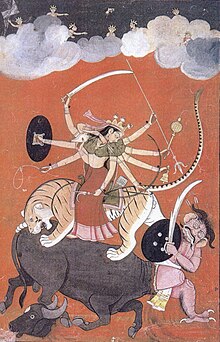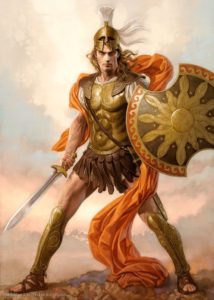
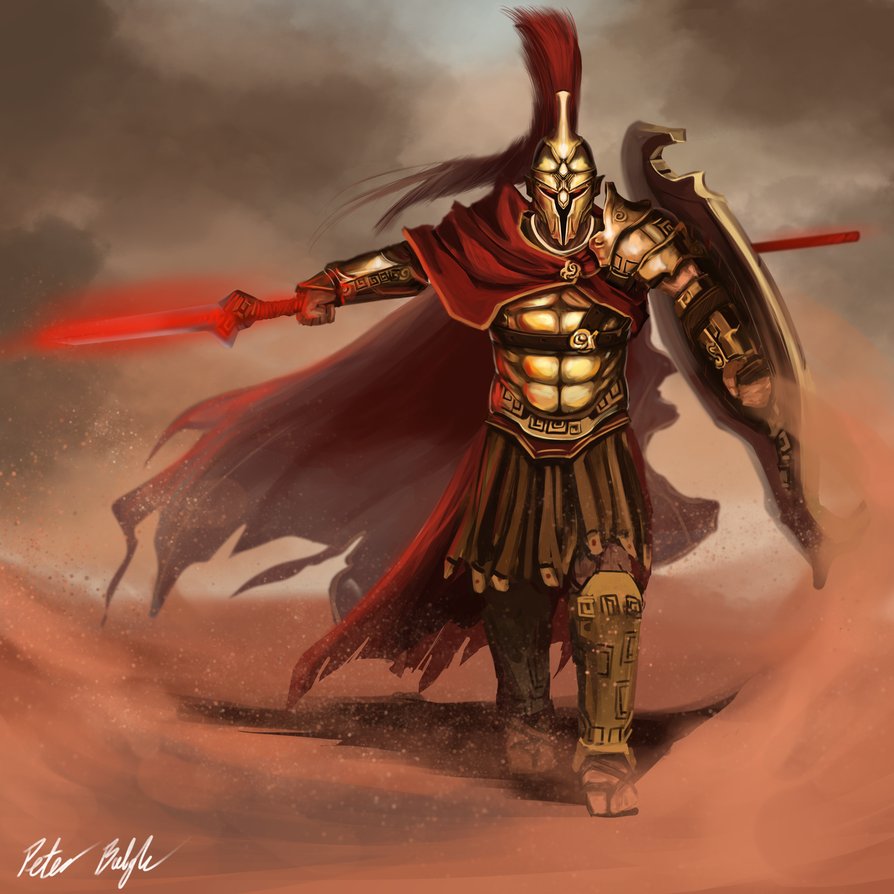
Rough Notes:
Ares
| Ares | |
|---|---|
| God of war | |

Statue of Ares from Hadrian’s Villa
|
|
| Abode | Mount Olympus, Thrace, Macedonia, Thebes, Sparta & Mani |
| Symbols | Sword, spear, shield, helmet, chariot, flaming torch, dog, boar, vulture |
| Personal Information | |
| Consort | Aphrodite and various others |
| Children | Erotes (Eros and Anteros), Phobos, Deimos, Phlegyas, Harmonia, Enyalios, Thrax, Oenomaus, Amazons and Adrestia |
| Parents | Zeus and Hera |
| Siblings | Aeacus, Angelos, Aphrodite, Apollo, Artemis, Athena, Dionysus, Eileithyia, Enyo, Eris, Ersa, Hebe, Helen of Troy, Hephaestus, Heracles, Hermes, Minos, Pandia, Persephone, Perseus, Rhadamanthus, the Graces, the Horae, the Litae, the Muses, the Moirai |
| Roman equivalent | Mars |
| This article contains special characters.Without proper rendering support, you may see question marks, boxes, or other symbols. |
| Part of a series on |
| Ancient Greek religion |
|---|
 |
|
Features[show]
|
|
Godheads[show]
|
|
Ethics[show]
|
|
Practices[show]
|
|
Sacred places[show]
|
|
Texts[show]
|
|
History[show]
|
Ares (/ˈɛəriːz/; Greek: Ἄρης [árɛːs]) is the Greek god of war. He is one of the Twelve Olympians, and the son of Zeus and Hera.[1] In Greek literature, he often represents the physical or violent and untamed aspect of war, in contrast to his sister the armored Athena, whose functions as a goddess of intelligence include military strategy and generalship.[2]
The Greeks were ambivalent toward Ares: although he embodied the physical valor necessary for success in war, he was a dangerous force, “overwhelming, insatiable in battle, destructive, and man-slaughtering.”[3] His sons Phobos (Fear) and Deimos (Terror) and his lover, or sister, Enyo (Discord) accompanied him on his war chariot.[4] In the Iliad, his father Zeus tells him that he is the god most hateful to him.[5] An association with Ares endows places and objects with a savage, dangerous, or militarized quality.[6] His value as a war god is placed in doubt: during the Trojan War, Ares was on the losing side, while Athena, often depicted in Greek art as holding Nike (Victory) in her hand, favoured the triumphant Greeks.[3]
Ares plays a relatively limited role in Greek mythology as represented in literary narratives, though his numerous love affairs and abundant offspring are often alluded to.[7] When Ares does appear in myths, he typically faces humiliation.[8] He is well known as the lover of Aphrodite, the goddess of love, who was married to Hephaestus, god of craftsmanship.[9] The most famous story related to Ares and Aphrodite shows them exposed to ridicule through the wronged husband’s device.[10]
The counterpart of Ares among the Roman gods is Mars,[11] who as a father of the Roman people was given a more important and dignified place in ancient Roman religion as a guardian deity. During the Hellenization of Latin literature, the myths of Ares were reinterpreted by Roman writers under the name of Mars. Greek writers under Roman rule also recorded cult practices and beliefs pertaining to Mars under the name of Ares. Thus in the classical tradition of later Western art and literature, the mythology of the two figures becomes virtually indistinguishable.
Contents
[hide]
Names[edit]
The etymology of the name Ares is traditionally connected with the Greek word ἀρή (arē), the Ionic form of the Doric ἀρά (ara), “bane, ruin, curse, imprecation”.[12][13] There may also be a connection with the Roman god of war, Mars, via hypothetical Proto-Indo-European *M̥rēs;[citation needed] compare Ancient Greek μάρναμαι (marnamai), “I fight, I battle”.[14] Walter Burkert notes that “Ares is apparently an ancient abstract noun meaning throng of battle, war.”[15] R. S. P. Beekes has suggested a Pre-Greek origin of the name.[16]
The earliest attested form of the name is the Mycenaean Greek ??, a-re, written in the Linear B syllabic script.[17][18][19]
The adjectival epithet, Areios, was frequently appended to the names of other gods when they took on a warrior aspect or became involved in warfare: Zeus Areios, Athena Areia, even Aphrodite Areia. In the Iliad, the word ares is used as a common noun synonymous with “battle.”[3]
Inscriptions as early as Mycenaean times, and continuing into the Classical period, attest to Enyalios as another name for the god of war.[n 1]
Character, origins, and worship[edit]
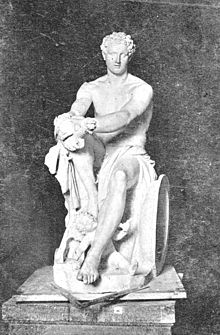
Vatican, Rome, Italy. Statue of Ares, Scopas‘s influence. Brooklyn Museum Archives, Goodyear Archival Collection
Ares was one of the Twelve Olympians in the archaic tradition represented by the Iliad and Odyssey. Zeus expresses a recurring Greek revulsion toward the god when Ares returns wounded and complaining from the battlefield at Troy:
Then looking at him darkly Zeus who gathers the clouds spoke to him:
“Do not sit beside me and whine, you double-faced liar.
To me you are the most hateful of all gods who hold Olympus.
Forever quarrelling is dear to your heart, wars and battles.
…
And yet I will not long endure to see you in pain, since
you are my child, and it was to me that your mother bore you.
But were you born of some other god and proved so ruinous
long since you would have been dropped beneath the gods of the bright sky.”[22]
This ambivalence is expressed also in the Greeks’ association of the god with the Thracians, whom they regarded as a barbarous and warlike people.[23] Thrace was Ares’s birthplace, his true home, and his refuge after the affair with Aphrodite was exposed to the general mockery of the other gods.[n 2]
A late-6th-century BC funerary inscription from Attica emphasizes the consequences of coming under Ares’s sway:
Stay and mourn at the tomb of dead Kroisos
Whom raging Ares destroyed one day, fighting in the foremost ranks.[24]
Ares in Sparta[edit]
In Sparta, Ares was viewed as a model soldier: his resilience, physical strength, and military intelligence were unrivaled. An ancient statue, representing the god in chains, suggests that the martial spirit and victory were to be kept in the city of Sparta. That the Spartans admired him is indicative of the cultural divisions that existed between themselves and other Greeks, especially the Athenians (see Pelopponesian War).
Ares in the Arabian Peninsula[edit]
Ares was also worshipped by the inhabitants of Tylos. It is not known if he was worshipped in the form of an Arabian god (or which one) or if he was worshipped in his Greek form.[25]
Attributes[edit]

The Ares Borghese.
The birds of Ares (Ornithes Areioi) were a flock of feather-dart-dropping birds that guarded the Amazons‘ shrine of the god on a coastal island in the Black Sea.[26]
Cult and ritual[edit]
Although Ares received occasional sacrifice from armies going to war, the god had a formal temple and cult at only a few sites.[27] At Sparta, however, each company of youths sacrificed a puppy to Enyaliosbefore engaging in ritual fighting at the Phoebaeum.[n 3] The chthonic night-time sacrifice of a dog to Enyalios became assimilated to the cult of Ares.[29]
Just east of Sparta stood an archaic statue of the god in chains, to show that the spirit of war and victory was to be kept in the city.[n 4]
The Temple of Ares in the agora of Athens, which Pausanias saw in the second century AD, had been moved and rededicated there during the time of Augustus. Essentially it was a Roman temple to the Augustan Mars Ultor.[27] From archaic times, the Areopagus, the “mount of Ares” at some distance from the Acropolis, was a site of trials. Paul the Apostle later preached about Christianity there. Its connection with Ares, perhaps based on a false etymology, is etiological myth.[citation needed] A second temple to Ares has been located at the archaeological site of Metropolis in what is now Western Turkey.[citation needed]
Attendants[edit]
Deimos, “Terror” or “Dread”, and Phobos, “Fear” or “Horror”, are his companions in war.[31] According to Hesiod, they were also his children, borne by Aphrodite.[32] Eris, the goddess of discord, or Enyo, the goddess of war, bloodshed, and violence, was considered the sister[citation needed] and companion of the violent Ares. In at least one tradition, Enyalius, rather than another name for Ares, was his son by Enyo.[33]
Ares may also be accompanied by Kydoimos, the demon of the din of battle; the Makhai (“Battles”); the “Hysminai” (“Acts of manslaughter”); Polemos, a minor spirit of war, or only an epithet of Ares, since it has no specific dominion; and Polemos’s daughter, Alala, the goddess or personification of the Greek war-cry, whose name Ares uses as his own war-cry. Ares’s sister Hebe (“Youth”) also draws baths for him.
According to Pausanias, local inhabitants of Therapne, Sparta, recognized Thero, “feral, savage,” as a nurse of Ares.[34]
Founding of Thebes[edit]
One of the roles of Ares was expressed in mainland Greece as the founding myth of Thebes: Ares was the progenitor of the water-dragon slain by Cadmus, for the dragon’s teeth were sown into the ground as if a crop and sprang up as the fully armored autochthonic Spartoi. To propitiate Ares, Cadmus took as a bride Harmonia, a daughter of Ares’s union with Aphrodite. In this way, Cadmus harmonized all strife and founded the city of Thebes.[35]
Consorts and children[edit]
The union of Ares and Aphrodite created the gods Eros, Anteros, Phobos, Deimos, Harmonia, and Adrestia. While Eros’s and Anteros’s godly stations favored their mother, Adrestia preferred to emulate her father, often accompanying him to war.[citation needed] Other versions include Alcippe as one of his daughters.
Upon one occasion, Ares incurred the anger of Poseidon by slaying his son, Halirrhothius, because he had raped Alcippe, a daughter of the war-god. For this deed, Poseidon summoned Ares to appear before the tribunal of the Olympic gods, which was held upon a hill in Athens. Ares was acquitted. This event is supposed to have given rise to the name Areopagus (or Hill of Ares), which afterward became famous as the site of a court of justice.[36]
Accounts tell of Cycnus (Κύκνος) of Macedonia, a son of Ares who was so murderous that he tried to build a temple with the skulls and the bones of travellers. Heracles slaughtered this abominable monstrosity, engendering the wrath of Ares, whom the hero wounded in conflict.[37]
List of Ares’s consorts and children[edit]
| Consorts | Children |
|---|---|
| 1. Aphrodite | 1. Phobos |
| 2. Deimos | |
| 3. Harmonia | |
| 4. Adrestia | |
| 5. Eros (part of the Erotes) | |
| 6. Anteros (part of the Erotes) | |
| 7. Himeros (part of the Erotes) | |
| 8. Pothos (part of the Erotes) | |
| 2. Aerope | 1. Aeropus |
| 3. Aglauros | 1. Alcippe |
| 4. Althaea | 1. Meleager (possibly) |
| 5. Anchiroe | 1. Sithon (possibly) |
| 6. Astyoche, daughter of Actor | 1. Ascalaphus |
| 2. Ialmenus | |
| 7. Atalanta | 1. Parthenopaeus (possibly) |
| 8. Caldene, daughter of Pisidus | 1. Solymus (possibly) |
| 9. Calliope (Muse) | 1.Mygdon |
| 2. Edonus (possibly) | |
| 3. Biston (possibly) | |
| 4. Odomantus (possibly) | |
| 10. Callirrhoe, daughter of Nestus | 1. Biston (possibly) |
| 2. Odomantus (possibly) | |
| 3. Edonus (possibly) | |
| 11. Critobule | 1. Pangaeus[38] |
| 12. Cyrene[39] | 1. Diomedes of Thrace |
| 2. Crestone[40] | |
| 13. Demonice | 1. Euenus |
| 2. Thestius | |
| 3. Molus | |
| 4. Pylus | |
| 14. Dormothea | 1. Stymphelus[41] |
| 15. Dotis / Chryse | 1. Phlegyas |
| 16. Enyo | 1. Enyalius |
| 17. Eos | |
| 18. Erinys of Telphusa (unnamed) | 1. Dragon of Thebes (slain by Cadmus) |
| 19. Harmonia | 1. The Amazons |
| 20. Leodoce (?)[42] | |
| 21. Otrera | 1. Hippolyta |
| 2. Antiope | |
| 3. Melanippe | |
| 4. Penthesilea | |
| 22. Parnassa / Aegina | 1. Sinope (possibly)[43] |
| 23. Phylonome | 1. Lycastus |
| 2. Parrhasius | |
| 24. Protogeneia | 1. Oxylus |
| 25. Pyrene / Pelopia | 1. Cycnus |
| 26. Sete, sister of Rhesus | 1. Bithys, eponym of the Bithyae, a Thracian tribe[44] |
| 27. Sterope (Pleiad) / Harpinna, daughter of Asopus / Eurythoe the Danaid | 1. Oenomaus |
| 28. Persephone (wooed her unsuccessfully) | |
| 29. Tanagra, daughter of Asopus | |
| 30. Tereine, daughter of Strymon | 1. Thrassa (mother of Polyphonte) |
| 31. Theogone | 1. Tmolus[45] |
| 32. Triteia | 1. Melanippus |
| 33. mothers unknown | 1. Alcon of Thrace[46] |
| 2. Chalyps, eponym of the Chalybes[47] | |
| 3. Cheimarrhoos, possible father of Triptolemus by Polyhymnia[48] | |
| 4. Dryas | |
| 5. Hyperbius | |
| 6. Lycus of Libya[49] | |
| 7. Nisos (possibly) | |
| 8. Portheus (Porthaon) | |
| 9. Tereus |
Hymns to Ares[edit]
- Homeric Hymn 8 to Ares (trans. Evelyn-White) (Greek epic 7th to 4th centuries BC)
- “Ares, exceeding in strength, chariot-rider, golden-helmed, doughty in heart, shield-bearer, Saviour of cities, harnessed in bronze, strong of arm, unwearying, mighty with the spear, O defence of Olympus, father of warlike Victory, ally of Themis, stern governor of the rebellious, leader of righteous men, sceptred King of manliness, who whirl your fiery sphere among the planets in their sevenfold courses through the aether wherein your blazing steeds ever bear you above the third firmament of heaven; hear me, helper of men, giver of dauntless youth! Shed down a kindly ray from above upon my life, and strength of war, that I may be able to drive away bitter cowardice from my head and crush down the deceitful impulses of my soul. Restrain also the keen fury of my heart which provokes me to tread the ways of blood-curdling strife. Rather, O blessed one, give you me boldness to abide within the harmless laws of peace, avoiding strife and hatred and the violent fiends of death.”[50]
- Orphic Hymn 65 to Ares (trans. Taylor) (Greek hymns 3rd century BC to 2nd century AD)
- “To Ares, Fumigation from Frankincense. Magnanimous, unconquered, boisterous Ares, in darts rejoicing, and in bloody wars; fierce and untamed, whose mighty power can make the strongest walls from their foundations shake: mortal-destroying king, defiled with gore, pleased with war’s dreadful and tumultuous roar. Thee human blood, and swords, and spears delight, and the dire ruin of mad savage fight. Stay furious contests, and avenging strife, whose works with woe embitter human life; to lovely Kyrpis [Aphrodite] and to Lyaios [Dionysos] yield, for arms exchange the labours of the field; encourage peace, to gentle works inclined, and give abundance, with benignant mind.”
Other accounts[edit]

The Ludovisi Ares, Roman version of a Greek original c. 320 BC, with 17th-century restorations by Bernini
Ares and Aphrodite[edit]
In the tale sung by the bard in the hall of Alcinous,[51] the Sun-god Helios once spied Ares and Aphrodite enjoying each other secretly in the hall of Hephaestus, her husband. He reported the incident to Hephaestus. Contriving to catch the illicit couple in the act, Hephaestus fashioned a finely-knitted and nearly invisible net with which to snare them. At the appropriate time, this net was sprung, and trapped Ares and Aphrodite locked in very private embrace.[n 5]
But Hephaestus was not satisfied with his revenge, so he invited the Olympian gods and goddesses to view the unfortunate pair. For the sake of modesty, the goddesses demurred, but the male gods went to witness the sight. Some commented on the beauty of Aphrodite, others remarked that they would eagerly trade places with Ares, but all who were present mocked the two. Once the couple was released, the embarrassed Ares returned to his homeland, Thrace, and Aphrodite went to Paphos.[n 5]
In a much later interpolated detail, Ares put the young soldier Alectryon by his door to warn them of Helios’s arrival as Helios would tell Hephaestus of Aphrodite’s infidelity if the two were discovered, but Alectryon fell asleep on guard duty.[citation needed] Helios discovered the two and alerted Hephaestus. The furious Ares turned the sleepy Alectryon into a rooster which now always announces the arrival of the sun in the morning.
Ares and the giants[edit]
In one archaic myth, related only in the Iliad by the goddess Dione to her daughter Aphrodite, two chthonic giants, the Aloadae, named Otus and Ephialtes, threw Ares into chains and put him in a bronze urn, where he remained for thirteen months, a lunar year. “And that would have been the end of Ares and his appetite for war, if the beautiful Eriboea, the young giants’ stepmother, had not told Hermes what they had done,” she related.[52] “In this one suspects a festival of licence which is unleashed in the thirteenth month.”[53]
Ares was held screaming and howling in the urn until Hermes rescued him, and Artemis tricked the Aloadae into slaying each other. In Nonnus‘s Dionysiaca[54] Ares also killed Ekhidnades, the giant son of Echidna, and a great enemy of the gods. Scholars have not concluded whether the nameless Ekhidnades (“of Echidna’s lineage”) was entirely Nonnus’s invention or not.
Iliad[edit]
In the Iliad,[55] Homer represented Ares as having no fixed allegiances, rewarding courage on both sides: he promised Athena and Hera that he would fight on the side of the Achaeans (Iliad V.830–834, XXI.410–414), but Aphrodite persuaded Ares to side with the Trojans. During the war, Diomedes fought with Hector and saw Ares fighting on the Trojans’ side. Diomedes called for his soldiers to fall back slowly (V.590–605).
Athene or Athena, Ares’s sister, saw his interference and asked Zeus, his father, for permission to drive Ares away from the battlefield, which Zeus granted (V.711–769). Hera and Athena encouraged Diomedes to attack Ares (V.780–834). Diomedes thrust with his spear at Ares, with Athena driving it home, and Ares’s cries made Achaeans and Trojans alike tremble (V.855–864). Ares fled to Mt. Olympus, forcing the Trojans to fall back.
When Hera mentioned to Zeus that Ares’s son, Ascalaphus, was killed, Ares overheard and wanted to join the fight on the side of the Achaeans, disregarding Zeus’s order that no Olympic god should enter the battle, but Athena stopped him (XV.110–128). Later, when Zeus allowed the gods to fight in the war again (XX.20–29), Ares was the first to act, attacking Athena to avenge himself for his previous injury. Athena overpowered him by striking Ares with a boulder (XXI.391–408).
Renaissance[edit]
In Renaissance and Neoclassical works of art, Ares’s symbols are a spear and helmet, his animal is a dog, and his bird is the vulture. In literary works of these eras, Ares is replaced by the Roman Mars, a romantic emblem of manly valor rather than the cruel and blood-thirsty god of Greek mythology.
In popular culture[edit]
Ares figures in war-themed video games and in popular fictions.
NASA named their transport ship as Ares, which replaced the Space Shuttle. This was an extension of NASA’s practice of using Roman and Greek names for their rockets and programs: Saturn for manned rockets, Mercury for a satellite program, and the Apollo program, rather than any association with the nature of the war god.
See also[edit]
- Related Greek deities
- Children by Aphrodite
- Harmonia (Concord)
- Eros (Passionate love)
- Phobos (Fear)
- Deimos (Terror)
- Adrestia (Revenge)
- Anteros (Requited love)
- Friends and counselors
- Attendants
- Achlys (Death)
- Androktasiai (Slaughter)
- Alala (War cry)
- Eris (Strife)
- Enyo (Violence)
- Hebe (Life)
- Homados (Battle din)
- Hysminai (Combat)
- Kydoimos (Confusion)
- Keres (Death spirits)
- Makhai (Spirits of battle)
- Palioxis (Backrush)
- Polemos (War)
- Proioxis (Onrush)
- Similar deities in non-Greek cultures
- Britannia
- Kathleen Ni Houlihan
- Liberty
- Mars
- Nergal, Babylonian god associated with the planet Mars
- Tyr, a Norse god of war
- List of war deities
- Archetypical characteristics
Notes and references[edit]
- Notes
- Jump up^ Enyalios is thought to be attested on the KN V 52 tablet as ?????, e-nu-wa-ri-jo.[20][21]
- Jump up^ Homer Odyssey viii. 361; for Ares/Mars and Thrace, see Ovid, Ars Amatoria, book ii.part xi.585, which tells the same tale: “Their captive bodies are, with difficulty, freed, at your plea, Neptune: Venus runs to Paphos: Mars heads for Thrace.”; for Ares/Mars and Thrace, see also Statius, Thebaid vii. 42; Herodotus, iv. 59, 62.
- Jump up^ “Here each company of youths sacrifices a puppy to Enyalius, holding that the most valiant of tame animals is an acceptable victim to the most valiant of the gods. I know of no other Greeks who are accustomed to sacrifice puppies except the people of Colophon; these too sacrifice a puppy, a black bitch, to the Wayside Goddess”.[28]
- Jump up^ “Opposite this temple [the temple of Hipposthenes] is an old image of Enyalius in fetters. The idea the Lacedaemonians express by this image is the same as the Athenians express by their Wingless Victory; the former think that Enyalius will never run away from them, being bound in the fetters, while the Athenians think that Victory, having no wings, will always remain where she is”.[30]
- ^ Jump up to:a b “Odyssey, 8.295”.
[In Robert Fagles‘s translation]: … and the two lovers, free of the bonds that overwhelmed them so, sprang up and away at once, and the Wargod sped Thrace, while Love with her telltale laughter sped to Paphos …
- References
- Jump up^ Hesiod, Theogony 921 (Loeb Classical Library numbering); Iliad, 5.890–896. By contrast, Ares’s Roman counterpart Mars was born from Junoalone, according to Ovid (Fasti 5.229–260).
- Jump up^ Walter Burkert, Greek Religion (Blackwell, 1985, 2004 reprint, originally published 1977 in German), pp. 141; William Hansen, Classical Mythology: A Guide to the Mythical World of the Greeks and Romans (Oxford University Press, 2005), p. 113.
- ^ Jump up to:a b c Burkert, Greek Religion, p. 169.
- Jump up^ Burkert, Greek Religion, p.169.
- Jump up^ Iliad 5.890–891.
- Jump up^ Hansen, Classical Mythology, pp. 114–115.
- Jump up^ Hansen, Classical Mythology, pp. 113–114; Burkert, Greek Religion, p. 169.
- Jump up^ Hansen, Classical Mythology, pp. 113–114. See for instance Ares and the giants below.
- Jump up^ In the Iliad, however, the wife of Hephaestus is Charis, “Grace,” as noted by Burkert, Greek Religion, p. 168.
- Jump up^ Odyssey 8.266–366; Hansen, Classical Mythology, pp. 113–114.
- Jump up^ Larousse Desk Reference Encyclopedia, The Book People, Haydock, 1995, p. 215.
- Jump up^ Harper, Douglas. “Ares”. Online Etymology Dictionary.
- Jump up^ ἀρή, Georg Autenrieth, A Homeric Dictionary. ἀρή. Liddell, Henry George; Scott, Robert; A Greek–English Lexicon at the Perseus Project.
- Jump up^ μάρναμαι in Liddell and Scott.
- Jump up^ Walter Burkert, Greek Religion (Harvard) 1985:pt III.2.12 p. 169.
- Jump up^ R. S. P. Beekes, Etymological Dictionary of Greek, Brill, 2009, pp. 129–130.
- Jump up^ Gulizio, Joannn. “A-re in the Linear B Tablets and the Continuity of the Cult of Ares in the Historical Period” (PDF). Journal of Prehistoric Religion. 15: 32–38.
- Jump up^ Raymoure, K.A. (2012). “a-re”. Minoan Linear A & Mycenaean Linear B. Deaditerranean.
- Jump up^ “The Linear B word a-re”. Palaeolexicon, Word study tool of ancient languages.
- Jump up^ Chadwick, John (1976). The Mycenaean World. Cambridge, UK: Cambridge University Press. p. 88. ISBN 0-521-29037-6. At Google Books.
- Jump up^ Raymoure, K.A. “e-nu-wa-ri-jo”. Minoan Linear A & Mycenaean Linear B. Deaditerranean. “KN 52 V + 52 bis + 8285 (unknown)”. DĀMOS: Database of Mycenaean at Oslo. University of Oslo. Archived from the original on 2014-03-19.
- Jump up^ Iliad, Book 5, lines 798–891, 895–898 in the translation of Richmond Lattimore.
- Jump up^ Iliad 13.301; Ovid, Ars Amatoria, II.10.
- Jump up^ Athens, NM 3851 quoted in Andrew Stewart, One Hundred Greek Sculptors: Their Careers and Extant Works, Introduction: I. “The Sources”
- Jump up^ الاحتلال المقدوني للبحرين ص ١٢٨
- Jump up^ Argonautica (ii.382ff and 1031ff; Hyginus, Fabulae 30.
- ^ Jump up to:a b Burkert, Greek Religion, p. 170.
- Jump up^ Pausanias, 3.14.9.
- Jump up^ “Ares”. academic.eb.com/levels/collegiate/article/9344. Britannica Academic, Encyclopædia Britannica. 2007-10-10. Retrieved 2017-01-16.
- Jump up^ Pausanias, 3.15.7.
- Jump up^ Iliad 4.436f, and 13.299f’ Hesiodic Shield of Heracles 191, 460; Quintus Smyrnaeus, 10.51, etc.
- Jump up^ Hesiod, Theogony 934f.
- Jump up^ Eustathius on Homer, 944
- Jump up^ Pausanias, Description of Greece, 3. 19. 7 – 8
- Jump up^ Burkert, Greek Religion, p.169.
- Jump up^ Berens, E.M.: Myths and Legends of Ancient Greece and Rome, page 113. Project Gutenberg, 2007.
- Jump up^ Bibliotheca 2. 5. 11 & 2. 7. 7
- Jump up^ Pseudo-Plutarch, On Rivers, 3. 2
- Jump up^ Bibliotheca 2. 5. 8
- Jump up^ Tzetzes on Lycophron, 499: Thrace was said to have been called Crestone after her.
- Jump up^ Pseudo-Plutarch, On Rivers, 19. 1
- Jump up^ Hyginus, Fabulae, 159
- Jump up^ Scholia on Apollonius Rhodius, Argonautica, 2. 946
- Jump up^ Stephanus of Byzantium, s. v. Bithyai
- Jump up^ Pseudo-Plutarch, On Rivers, 7. 5
- Jump up^ Hyginus, Fabulae, 173
- Jump up^ Scholia on Apollonius Rhodius, Argonautica, 2. 373
- Jump up^ Scholia on Hesiod, Works and Days, 1, p. 28
- Jump up^ Pseudo-Plutarch, Greek and Roman Parallel Stories, 23
- Jump up^ Homeric Hymn to Ares.
- Jump up^ Odyssey 8.300
- Jump up^ Iliad 5.385–391.
- Jump up^ Burkert (1985). Greek Religion. p. 169.
- Jump up^ Nonnus, Dionysiaca 18. 274 ff; Theoi.com, “Ekhidnades”.
- Jump up^ References to Ares’s appearance in the Iliad are collected and quoted at www.theoi.com: Ares Myths 2
Mars
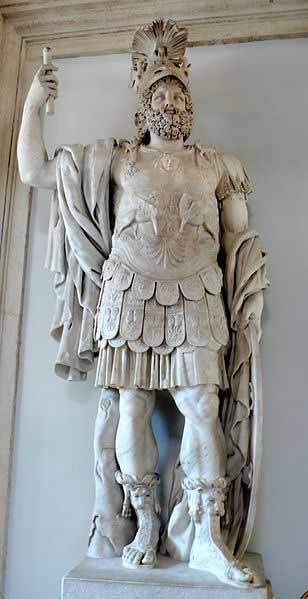
Mars was the god of war, and one of the most prominent and worshipped gods. In early Roman history he was a god of spring, growth in nature, and fertility, and the protector of cattle. Mars is also mentioned as a chthonic god (earth-god) and this could explain why he became a god of death and finally a god of war. He is the son of Jupiter and Juno. According to some sources, Mars is the father of Romulus and Remus by the Vestal Ilia (Rhea Silvia). Because he was the father of these legendary founders of Rome, and thus of the Roman people, the Romans styled themselves ‘sons of Mars’.
His main sanctuaries where the temple on the Capitol, which he shared with Jupiter and Quirinus, the temple of Mars Gradivus (“he who precedes the army in battle”) where the Roman army gathered before they went to war, and the temple of Mars Ultor (“the avenger”), located on the Forum Augustus. The Campus Martius (“field of Mars”), situated beyond the city walls, was also dedicated to him. Here the army was drilled and athletes were trained. In the Regia on the Forum Romanum, the ‘hastae Martiae’ (“lances of Mars”) were kept. When these lances ‘moved’, it was seen as a portent of war. The warlord who was to lead the army into battle had to move the lances while saying ‘Mars vigila’ (“Mars awaken”). As Mars Gradivus, the god preceded the army and led them to victory.
He had several festivals in his honor. On March 1, the Feriae Marti was celebrated. The Armilustrium was held on October 19, and on this day the weapons of the soldiers were ritually purified and stored for winter. Every five years the Suovetaurilia was held. During these fertility and cleansing rites, a pig (sus), a sheep (ovis) and bull (taurus) were sacrificed. The Equirria were on February 27 and March 14, on which horse races were held. The Quinquatrus was on March 19 and the Tubilustrium on March 23, on which weapons and war-trumpets were cleansed. The priests of Mars, who also served Quirinus, were called the Salii (“jumpers”), derived from the procession through the streets of the city which they completed by jumping the entire way and singing the Carmen Saliare. Mars’ own priest was called the flamen Martialis.
Mars is portrayed as a warrior in full battle armor, wearing a crested helmet and bearing a shield. His sacred animals are the wolf and the woodpecker, and he is accompanied by Fuga and Timor, the personifications of flight and fear. The month March (Martius) is named after him (wars were often started or renewed in spring). His Greek equivalent is the god Ares.
ANCIENT AND LOST CIVILIZATIONS
ALPHABETICAL INDEX OF ALL FILES
List of war deities
|
|
[hide]This article has multiple issues. Please help improve it or discuss these issues on the talk page. (Learn how and when to remove these template messages)
|
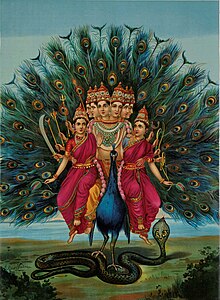
Kartikeya, Hindu god of war
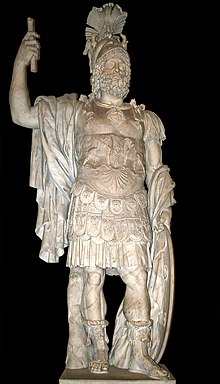
Mars, the Roman god of war
A war deity is a god or goddess in mythology associated with war, combat, or bloodshed. They occur commonly in both monotheistic and polytheistic religions.
Unlike most gods and goddesses in polytheistic religions, monotheistic deities have traditionally been portrayed in their mythologies as commanding war in order to spread their religion. (The intimate connection between “holy war” and the “one true god” belief of monotheism has been noted by many scholars; including Jonathan Kirsch in his book God Against The Gods: The History of the War Between Monotheism and Polytheism and Joseph Campbell in The Masks of God, Vol. 3: Occidental Mythology.) [1][2]
The following is a partial list of war deities.
Contents
[hide]
- 1African mythology
- 2Armenian mythology
- 3Aztec mythology
- 4Baltic mythology
- 5Berber mythology
- 6Celtic mythology
- 7Chinese mythology
- 8Continental Germanic mythology
- 9Egyptian mythology
- 10Etruscan mythology
- 11Greek mythology
- 12Hawaiian mythology
- 13Hinduism
- 14Hittite mythology
- 15Hungarian mythology
- 16Japanese mythology
- 17Lusitanian mythology
- 18Māori mythology
- 19Maya mythology
- 20Mesopotamian mythology
- 21Mongolian shamanism
- 22Native American mythology
- 23Norse mythology
- 24Nuristani mythology
- 25Paleo-Balkan mythology
- 26Polynesian mythology
- 27Roman mythology
- 28Semitic mythology
- 29Slavic mythology
- 30Turco-Mongol mythology
- 31Vietnamese mythology
- 32Vodou
- 33References
African mythology[edit]
- Agurzil, Berber god of war
- Apedemak, Nubian lion-headed warrior god
- Kokou, powerful Yoruba warrior god
- Maher, Ethiopian god of war
- Ogoun, Yoruba deity who presides over fire, iron, hunting, politics, and war
- Oya, Yoruba warrior-goddess of the Niger River
Armenian mythology[edit]
- Anahit, goddess of fertility, birth, beauty, and water; in early periods associated with war
Aztec mythology[edit]
- Patterns of War
- Mixcoatl, god of war and hunting.
- Xipe-Totec, god of force, patron of war, agriculture, vegetation, diseases, seasons, rebirth, hunting, trades, and Spring, the lord of the East.
- Tlaloc, god of thunder, rain, and earthquakes.
- Xiuhtecuhtli, god of fire.
- Huitzilopochtli, god of will, patron of war, fire, and sun, the lord of the South.
Baltic mythology[edit]
- Kara Māte, Latvian goddess of war
- Kauriraris, Lithuanian god of war and war steeds
- Kovas, Lithuanian god of war
Berber mythology[edit]
- Gurzil, war god
- Ifri, war goddess
Celtic mythology[edit]
- Agrona, reconstructed Proto-Celtic name for the river Aeron in Wales, and possibly the name of an associated war goddess
- Andarta, Brittonic goddess theorised to be associated with victory, overcoming enemies, war
- Alaisiagae, a pair of goddesses worshiped in Roman Britain, with parallel Celtic and Germanic titles
- Andraste, Gaulish warrior goddess
- Anann, Irish goddess of war, death, predicting death in battle, cattle, prosperity, and fertility
- Bandua, Gallaecian God of War
- Badb, Irish goddess of war who took the form of a crow; member of the Morrígan
- Belatucadros, war god worshipped by soldiers and equated with the Roman war god Mars
- Camulus, god of war of the Belgic Remi and British Trinovantes
- Catubodua, Gaulish goddess assumed to be associated with victory
- Cicolluis, Gaulish and Irish god associated with war
- Cocidius, Romano-British god associated with war, hunting and forests
- Macha, Irish goddess associated with war, horses, and sovereignty; member of the Morrígan
- The Morrígan, Irish triple goddess associated with sovereignty, prophecy, war, and death on the battlefield
- Neit, Irish god of war, husband of Nemain of Badb
- Nemain, Irish goddess of the frenzied havoc of war; member of the Morrígan
- Rudianos, Gaulish god of war
- Segomo, Gaulish god of war
- Teutates, British and Gaulish god of war and the tribe
Chinese mythology[edit]
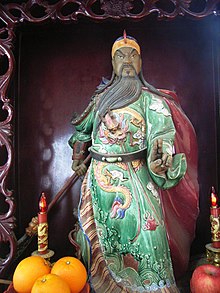
Guan Yu, Chinese god of loyalty, righteousness, and valor
- Jiutian Xuannü, goddess of war, sexuality, and longevity[3]
- Chiyou, God of War
- Yang Jian, Three Eyed Warrior
- Jinzha, Marshal of the Center Altar
- Muzha, Marshal of the Center Altar
- Li Jing, Heavenly King & Holder of the Pagoda.
- Wen Qiong[4]
- Nezha (the family name Li come from his father, Li Jing)
- Guan Yu, god of Loyalty, righteousness, and valor
- Yue Fei
Continental Germanic mythology[edit]
- Baduhenna, a western-Frisii goddess of warfare
- Wōden, god associated with wisdom, war, battle, and death, as well as also magic, poetry, prophecy, victory, and the hunt
Egyptian mythology[edit]
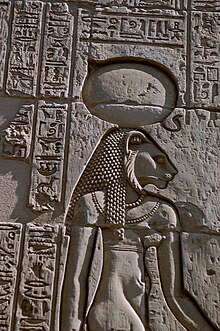
Sekhmet, Egyptian warrior goddess
- Anhur, god of war
- Bast, cat-headed goddess associated with war, protection of Lower Egypt and the pharaoh, the sun, perfumes, ointments, and embalming
- Horus, god of the king, the sky, war, and protection
- Maahes, lion-headed god of war
- Menhit, goddess of war, “she who massacres”
- Montu, falcon-headed god of war, valor, and the Sun
- Neith, goddess of war, hunting, and wisdom
- Pakhet, goddess of war
- Satis, deification of the floods of the Nile River and an early war, hunting, and fertility goddess
- Sekhmet, goddess of warfare, pestilence, and the desert
- Set, god of chaos, associated with war
- Sobek, god of the Nile, the army, military, fertility and of crocodiles
- Sopdu, god of the scorching heat of the summer sun, associated with war
- Wepwawet, wolf-god of war and death who later became associated with Anubis and the afterlife
Etruscan mythology[edit]
Greek mythology[edit]
- Alala, spirit of the war cry
- Alke, spirit of courage and battle-strength
- Amphillogiai, goddesses of disputes
- Androktasiai, spirits of battlefield slaughter
- Ares, god of war, bloodlust, weapons of war, the defence and sacking of cities, rebellion, civil order, banditry, manliness, and courage; the son of Zeus and Hera
- Athena, goddess of wisdom, war strategy, heroic endeavour, handicrafts, and reason
- Bia, spirit of force and compulsion
- Deimos, personification of terror
- Enyalius, god of battle
- Enyo, goddess of war
- Eris, goddess of discord, chaos and strife
- Homados, spirit of the din of battle
- Hysminai, female spirits of fighting and combat
- Ioke, spirit of onslaught, battle-tumult, and pursuit
- Keres, female spirits of violent or cruel death, including death in battle, by accident, murder, or ravaging disease
- Kratos, the personification of strength and power
- Kydoimos, spirit of the din of battle
- Makhai, male spirits of fighting and combat
- Nike, spirit of victory
- Palioxis, spirit of backrush, flight, and retreat from battle
- Pallas, Titan god of warcraft and of the springtime campaign season
- Perses, the Titan of destruction
- Phobos, spirit of panic, fear, flight, and battlefield route
- Phonoi, spirits of murder, killing, and slaughter
- Polemos, spirit of war
- Proioxis, spirit of onrush and battlefield pursuit
Hawaiian mythology[edit]
Hinduism[edit]
- Chamunda, Goddess of war and disease
- Durga, The fiercer, demon-fighting form of Shiva‘s wife, the goddess Parvati
- Hanuman, God associated with war, wisdom, and courage
- Indra, God of war, storms, and rainfall
- Kali, Goddess associated with time, change, and war
- Kartikeya, God of war and battle
- Kathyayini, Goddess of vengeance and victory
- Mangala, God of war
- Matrikas, Goddesses of war, children, and emancipation
- Parasurama, Axe God “Rama with an axe”, God of war and battle,
- Shiva, God of avenging and destroying
- Bhaargava, The axe warrior a.k.a. Parashurama
- Yama, God of Death
- Narasimha, God of Justice
- Ganesha, Heroically taking action against demons
- Kalki, Destroyer of foulness, darkness and ignorance
- Virabhadra, The God of Warriors
- Nirrti, Goddess of Strife
- Rama, God associated with War, Justice, Kingship
- Krishna, God of strategies of War
Hittite mythology[edit]
- Shaushka, goddess of fertility, war, and healing
- Wurrukatte, god of war
Hungarian mythology[edit]
- Hadúr, god of war and the metalsmith of the gods
Japanese mythology[edit]
- Hachiman Daimyōjin, Shinto god of war (on land) and agriculture, divine protector of the Minamoto clan and Imperial Dynasty ownership of Japan
- Takemikazuchi-no-kami, god of war, conquest, martial arts, Sumo, and lightning; general of the Amatsukami; god of Kashima and Ujigami of Nakatomi clan
- Futsunushi, god of swords, martial arts, and conquest; god of the Mononobe clan
- Sarutahiko Ōkami, deity of war and misogi; the Great God who stands at the junction of Heaven and Earth; one of the main Kunitsukami; actively worshipped by Ueshiba Morihei
- Suwa Myōjin (Takeminakata-no-kami), god of valor and duty, protector of Japanese religion
- Bishamonten, armor-clad god of war
Lusitanian mythology[edit]
- Neto, god believed to be associated with war, death, and weaponry

Inanna, Mesopotamian goddess of sexual love, fertility, and warfare
Māori mythology[edit]
- Tūmatauenga, god of war
Maya mythology[edit]
- Tohil, god associated with fire, the sun, rain, mountains and war
Mesopotamian mythology[edit]
- Belus, Babylonian god of war
- Inanna, Sumerian goddess of sexual love, fertility, and warfare
- Ishtar, Assyrian and Babylonian counterpart to Inanna
- Nergal, Babylonian god of war, fire, the underworld, and pestilence
- Pap-nigin-gara, Akkadian and Babylonian god of war
- Sebitti, group of minor Akkadian and Babylonian war gods
- Shala, Akkadian and Babylonian goddess of war and grain
- Shara, minor Sumerian god of war
- Shulmanu, god of the underworld, fertility, and war
Mongolian shamanism[edit]
Native American mythology[edit]
- Qamaits, Nuxálk warrior goddess
- Winalagalis, Kwakwaka’wakw god of war
Norse mythology[edit]
- Freyja, goddess associated with love, beauty, fertility, gold, seiðr, war, and death
- Odin, god associated with wisdom, war, battle, and death
- Thor, god associated with thunder, strength, defense, oaks, goats, lightning, storms, weather, crops, trading voyages, courage, trust, revenge, protection, warfare, and battles
- Týr, god associated with honor, law (the “Allthing”), justice in battle, victory, and heroic glory
- Ullr, god associated with archery, male beauty, skiing, winter sports, single combat, and war
Nuristani mythology[edit]
- Great Gish, god of war
Paleo-Balkan mythology[edit]
- Thracian Rider
- Sabazios
- Danubian Rider
Polynesian mythology[edit]
- ‘Oro, god of war
Roman mythology[edit]
- Bellona, goddess of war
- Honos, god of chivalry, honor, and military justice
- Mars, god of war and agriculture, equivalent to the Greek god Ares
- Minerva, goddess of wisdom and war, equivalent to the Greek goddess Athena
- Nerio, warrior goddess and personification of valor
- Victoria, personification of victory, equivalent to the Greek goddess Nike
- Virtus, god of bravery and military strength
Semitic mythology[edit]
- Agasaya, “the Shrieker”, goddess of war
- Anat, goddess of war
- Astarte, goddess of fertility, sexuality, and war, associated with the Mesopotamian Ishtar or Inanna
- Resheph, god of plague and war
- Tanit, Phoenician lunar goddess associated with war
Slavic mythology[edit]
- Jarovit, god of vegetation, fertility, and spring, also associated with war and harvest
- Perun, god of thunder and lightning, associated with war
- Radegast, West Slavic god of hospitality, fertility and crops, associated with war and the sun; may or may not have been worshipped by ancient Slavs
- Svetovid, god of war, fertility, and abundance
- Zorya Utrennyaya, goddess of the morning star, sometimes depicted as a warrior goddess who protected men in battle
- Serbon, Illyrian god of fertility and war
Turco-Mongol mythology[edit]
- Kyzaghan, Turkic deity of war
Vietnamese mythology[edit]
- Thánh Gióng, god of triumph over foreign invaders
- Thần Đồng Cổ, the armored protector of Lý dynasty.
- Độc Cước, the protector of coastal settlements. Legend has it that he split himself in two with his axe, each half guards coastal villages against sea ogres.
- Cao Lỗ, god of military innovations.
Vodou[edit]
- Ogoun, loa who presides over fire, iron, hunting, politics, and war
References[edit]
- Jump up^ Kirsch, J. (2004). God Against the Gods: The History of the War Between Monotheism and Polytheism. Viking Compass. ISBN 9780670032860. Retrieved 2015-06-22.
- Jump up^ “Occidental Mythology (Masks of God): Joseph Campbell: 9780140194418: Amazon.com: Books”. amazon.com. Retrieved 2015-06-22.
- Jump up^ Cahill, Suzanne E. (18 July 2013). “Sublimation in Medieval China: The Case of the Mysterious Woman of the Nine Heavens”. Journal of Chinese Religions. 20 (1): 91–102. doi:10.1179/073776992805307692.
- Jump up^ http://etheses.lib.cuhk.edu.hk/pdf/004777762.pdf


